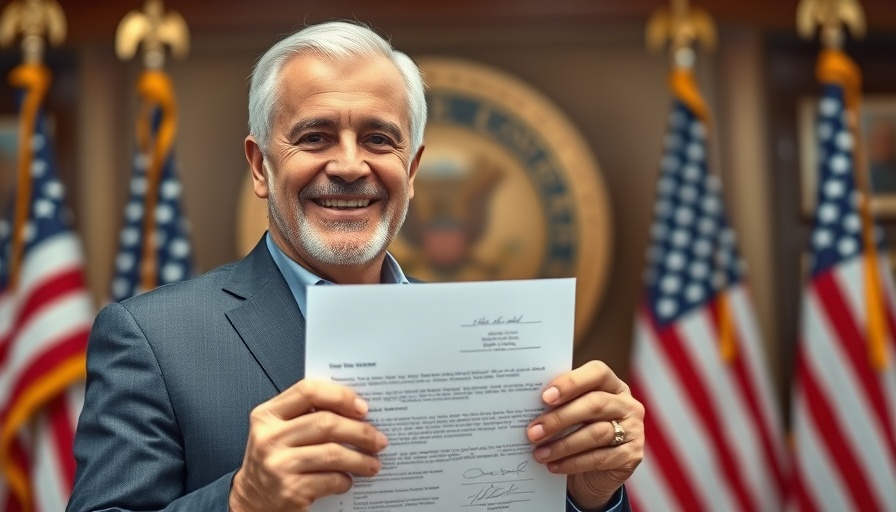
Trump's AI Action Plan: The Unseen Landscape of Opportunity
The recent unveiling of President Donald Trump’s Artificial Intelligence Action Plan marks a pivotal moment in the realm of technological policy. As industries converge to harness the full potential of AI, understanding the intricacies behind Trump's plan is crucial for businesses keen to navigate this transformative landscape.
Defining the AI Strategy: Beyond the Headlines
At first glance, Trump's AI Action Plan appears to focus on standard themes: competition with China, deregulation to facilitate technological growth, and a push for ideologically neutral AI systems. Yet, as we delve deeper, it becomes evident that the implications extend far beyond the surface. The strategy promotes a massive investment in data centers, urging a reduction in environmental regulations that govern their operation. This aspect encourages a rapid expansion of AI services but raises questions about environmental sustainability.
The Clash with the Federal Trade Commission
One standout feature of the AI plan is its aggressive stance against the Federal Trade Commission (FTC). Under the Biden administration, the FTC intensified scrutiny on AI, focusing on accuracy claims and consumer harm. Trump’s strategy, however, aims to roll back what he deems excessive regulations. By reevaluating FTC actions, the Trump administration may weaken this vital protector of consumer interests, potentially leading to a more unrestrained AI market.
Scientific Innovation: Balancing Optimism and Realism
Central to the AI Action Plan is a bold vision of AI as a transformative force in scientific research. The administration touts AI's capacity to drive breakthroughs in material science and drug discovery, citing recent successes like Google's DeepMind. However, the idea that AI can operate independently in scientific inquiry remains speculative. For businesses invested in tech advancements, this aspect presents both opportunities for innovation and risks associated with overreliance on emerging technologies.
The Push for Ideological Neutrality in AI Systems
Another critical component of the plan directs federal funding toward AI companies committed to avoiding 'top-down ideological bias.' By prioritizing neutrality, the administration hopes to foster an AI ecosystem that caters equally to diverse perspectives. This approach seeks to promote a balanced representation in technology, yet businesses must grapple with the subjective nature of what constitutes bias in AI training data.
Practical Implications for Businesses
As the AI landscape evolves, businesses must adapt to new regulatory frameworks and opportunistic dynamics. Trump's emphasis on deregulation can lead to an influx of innovative startups. However, companies must also prepare for a potential backlash stemming from reduced oversight, particularly in consumer protection. This evolving environment necessitates agility from businesses seeking to leverage AI technologies effectively.
Future Trends: Monitoring the AI Landscape
Looking ahead, understanding the implications of this action plan is critical for stakeholders in the technology arena. Experts predict that friction between state regulations and federal initiatives concerning AI will continue to reshape the industry. Businesses need to remain vigilant about policies, as they will play a pivotal role in determining competitive advantages in this fiercely contested market.
The Role of Businesses in Shaping AI Policy
We must remember that the trajectory of AI policy is significantly influenced by corporate engagement. Companies not only have to adapt to existing policies but can also play a proactive role in shaping future regulations that balance innovation with ethical considerations. By participating in policy discussions and advocating for responsible AI development, businesses can help ensure that the evolution of AI aligns with broader societal values.
Conclusion: Engage with the Future of AI
The complexities of Trump's AI Action Plan may seem overwhelming at first, yet they also offer substantial opportunities for innovation and growth. Recognizing the interplay between technology and policy could yield significant competitive advantages. As we move further into 2025, it is imperative for businesses to educate themselves about these developments. Stay informed, engage in discussions about ethical AI use, and prepare to navigate the shifting landscape of technology effectively. Don't miss out on the future—start exploring how AI can enhance your business operations today!
 Add Row
Add Row  Add
Add 




Write A Comment